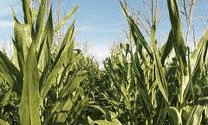 US – In this week’s "Market Preview" from National Hog Farmer magazine, Steve Meyer writes about corn yield prediction for 2011.
US – In this week’s "Market Preview" from National Hog Farmer magazine, Steve Meyer writes about corn yield prediction for 2011.
When it rains it pours. If anything can go wrong, it will. Or in the famous words of Rosanne Rosannadanna of Saturday Night Live, "It just goes to show you, Jane, if it’s not one thing, it’s another." Just doesn’t have the impact without Gilda Radner’s nasal voice, does it?
Unfortunately, all of the truisms for a fateful occurrence may be coming true with this year’s corn crop. Pro Farmer’s annual crop tour, which sends a group of farmers and crop scouts on a prescribed route across the Midwest to collect corn and soybean samples from which they estimate state and national yields, resulted in an estimated corn yield of 147.9 bushels per acre. That the Pro Farmer estimate was low was a foregone conclusion given the state-by-state data that had been released during the week. But it was even lower than a number of other revised forecasts that had come in under 150 bushels per acre.
Should the Pro Famer yield be correct and corn usage remain at the levels forecast by USDA in the August World Agriculture Supply and Demand Estimates (WASDE), year-end carryout stocks next August would be 283 million bushels or just 2.2 per cent of total usage (Figure 1). Both figures would be, by far, the lowest on record.

Will the market tolerate such a low level of year-end corn stocks? I don’t think so. Year-end stocks have dropped below 500 million bushels only once in history. That was in 1996, and that year’s 426 million bushels accounted for 5 per cent of total usage. Observers once believed that necessary “pipeline” supplies amounted to about 1 billion bushels, but in four other years since 1993, including last year, we have taken year-end stocks below that level with the averages of those four years being 893 million bushels and 9.3 per cent stocks-to-use ratio.
The evidence suggests that the trade will allow stocks to dip lower than in those four years but getting to 426 million, the 1996 level, is doubtful, I think. Recall that the 1995 corn yield was 25 bushels lower than that of 1994 and was 13.6 bushels below the trend yield value of 127.1 for that year. Prices started rising that fall and then exploded in the first quarter of 1996, before dropping back to 1995 levels as the 1996 crop developed. That crop was no bin buster but the yield was within 2 bushels of trend, and those high prices got more than 10 per cent more acres of corn planted and harvested in 1996.
So where will the market allow year-end stocks to settle? I think 600-700 million bushels is a minimum. If we figure 650 million, it means that, with the Pro Farmer yield, the market must save 367 million bushels.
Ethanol will not decline much, if any, unless oil and gasoline prices – and thus ethanol prices — get MUCH lower. The projected 5.1 billion bushels for ethanol in the 2011-2012 crop year is 500 million bushels more than will be necessary to meet the renewable fuel standard (RFS) of 12.87 billion gallons (a weighted average of one-third of the 2011 RFS and two-thirds of the 2012 RFS) during that time period.
As can be seen in Figure 2, ethanol margins have been very good this year. The latest observation in this chart for Iowa State University’s Center for Agricultural and Rural Development (CARD) is based on $6.72 corn. Other data from USDA points to gross margins (ie. ethanol revenue + DDGS revenue – corn cost) of well over $2.00 per bushel of corn with corn priced at $7.95/bushel. The economics still favor ethanol.

Exports may fall but the weak (and still weakening) US dollar will keep US corn priced competitively unless customer countries’ currencies gain substantially.
Finally, non-ethanol food, seed and industrial usage seem almost immune to corn supplies or prices. And with sugar prices still near record highs, it is difficult to argue that we will make less high fructose corn syrup in the year to come.
Corn Rationing
So the rationing will fall on feed and residual use. But before this corn price run-up, there was very little, if any, expected reduction in total feed usage.
There will be fewer cattle on feed at some point during the corn marketing year, but that probably will not happen until near the end of 2011 or perhaps into early 2012. There are fewer chickens being placed each week and I think that trend will continue, meaning that corn usage by the broiler sector will fall. But a higher proportion of large boning birds will offset some of that decline. Dairy cow numbers are growing. Hog numbers were expected to grow by 1-2 per cent in 2012 given some forecast profits and growing productivity. Turkey numbers will stay at least steady and may grow slightly given the profitability of that sector.
Without a further decline in oil prices, it appears to me that corn prices will rise to the point that livestock and poultry producers have to cut back. While demand has been strong, it is doubtful we can push wholesale and retail prices high enough and fast enough to cover higher corn prices. The "perfect storm" that I and many others have predicted may be happening.
http://www.thepigsite.com/swinenews/27382/market-preview-corn-yield-predictions-dip?

Deprecated: strpos(): Passing null to parameter #1 ($haystack) of type string is deprecated in /home/agriviek8Qv/agriviet.net/public_html/wp-includes/comment-template.php on line 2522